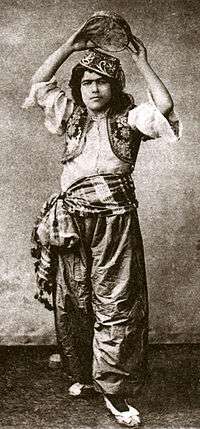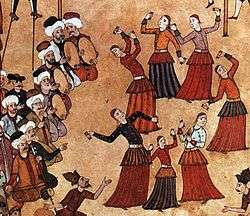Köçek
The köçek (plural köçekler in Turkish) was typically a very handsome young male rakkas, or dancer, who usually cross-dressed in feminine attire, and was employed as an entertainer.[1]

Roots
The Turkish word is derived from the Persian word kuchak, meaning "little", "small", or "young", which itself is the Persian pronunciation of the Turkish word küçük, "little".[2] In the Crimean Tatar language, the word köçek means "baby camel".[3]
The culture of the köçek, which flourished from the 17th to the 19th century, had its origin in the customs in Ottoman palaces, and in particular in the harems. It was played by feminine boys . Its genres enriched both the music and the dance of the Ottomans.[1]
The support of the Sultans was a key factor in its development, as the early stages of the art form was confined to palace circles.[4] From there the practice dispersed throughout the Empire by means of independent troupes.[1]
Culture

A köçek would begin training around the age of seven or eight and would be considered accomplished after about six years of study and practice. A dancer's career would last as long as he was beardless and retained his youthful appearance.[5]
They were recruited from among the ranks of the non-Muslim subject nations of the empire, such as Jews, Romani, Greeks and Albanians.[6] The dances, collectively known as köçek oyunu, blended Arab, Greek, Assyrian and Kurdish elements (Karsilamas dance and Kaşık Havası dance).[7] They were performed to a particular genre of music known as köçekçe, which was performed in the form of suites in a given melody. It too was a mix of Sufi, Balkan and classical Anatolian influences, some of which survives in popular Turkish music today. The accompaniment included various percussion instruments, such as the davul-köçek, the davul being a large drum, one side covered with goat skin and the other in sheep skin, producing different tones. A köçek's skill would be judged not only on his dancing abilities but also on his proficiency with percussion instruments, especially a type of castagnette known as the çarpare.[1] The dancers were accompanied by an orchestra, featuring four to five each kaba kemençe and laouto as principal instruments, used exclusively for köçek suites.[8] There were also two singers. A köçek dance in the Ottoman seraglio (palace harem) involved one or two dozen köçeks and many musicians.[1] The occasions of their performances were wedding or circumcision celebrations, feasts and festivals, as well as the pleasure of the sultans and the aristocracy.
The youths, often wearing heavy makeup, would curl their hair and wear it in long tresses under a small black or red velvet hat decorated with coins, jewels and gold. Their usual garb consisted of a tiny red embroidered velvet jacket with a gold-embroidered silk shirt, shalvar (baggy trousers), a long skirt and a gilt belt, knotted at the back. They were said to be "sensuous, attractive, effeminate", and their dancing "sexually provocative". Dancers minced and gyrated their hips in slow vertical and horizontal figure eights, rhythmically snapping their fingers and making suggestive gestures. Often acrobatics, tumbling and mock wrestling were part of the act. The köçeks were available sexually, often to the highest bidder, in the passive role.[9][10]
Famous poets, such as Fazyl bin Tahir Enderuni, wrote poems, and classical composers, such as the court musician Hammamizade İsmail Dede Efendi (1778–1846), composed köçekçes for celebrated köçeks. Many Istanbul meyhanes (nighttime taverns serving meze, rakı or wine) hired köçeks. Before starting their performance, the köçek danced among the spectators, to make them more excited. In the audience, competition for their attention often caused commotions and altercations. Men would go wild, breaking their glasses, shouting themselves voiceless, or fighting and sometimes killing each other vying for the boys' sexual favors.[11] This resulted in suppression of the practice under Sultan Abd-ul-Mejid I.[1]
As of 1805, there were approximately 600 köçek dancers working in the taverns of the Turkish capital. They were outlawed in 1837 due to fighting among audience members over the dancers.[12] With the suppression of harem culture under Sultan 'Abdu'l-'Aziz (1861–1876) and Sultan Abdul Hamid II (1876–1908), köçek dance and music lost the support of its imperial patrons and gradually disappeared.[13]
Köçeks were much more sought after than the çengi ("belly dancers"), their female counterparts. Some youths were known to have been killed by the çengi, who were extremely jealous of men's attention toward the boys.[11][14]
Modern offshoots
A modern interpretation is the movie Köçek (1975) by director Nejat Saydam. The movie follows the life of Caniko, an androgynous Gypsy, who struggles with his gender identity.[15][16]
See also
- Bacha bazi, Afghan equivalent
- Khawal, Egyptian equivalent
- Culture of the Ottoman Empire
- Ghilman
- Harem
- LGBT topics and Islam
- Ottoman Turkish language
- Bülbül olsam kona da bilsem dallere
Notes
- Prof. Ş. Şehvar BEŞİROĞLU. "Music, Identity, Gender: Çengis, Köçeks, Çöçeks". ITU Turkish Music State Conservatory, Musicology Department.
- "köçek". Nisanyansozluk.com. Retrieved 2011-12-05.
- Üseinov, S.M. (2007). "Rusça-Qırımtatarca, Qırımtatarca-Rusça luğat". Aqmescit, Tezis.
- Stephen O. Murray, Will Roscoe (1997). Islamic Homosexualities: Culture, History, and Literature. NYU Press. ISBN 0814774687.
- Anthony Shay (2014). The Dangerous Lives of Public Performers: Dancing, Sex, and Entertainment in the Islamic World. Palgrave MacMillan. p. 25. ISBN 978-1-349-49268-8.
- "Mevâid'de eşcinsel kültür". ibnistan.net. Archived from the original on March 4, 2016.
- "Ελευθεροτυπία - Το ελληνικό γιουσουφάκι!". Archive.enet.gr. Retrieved 2011-12-05.
- "The Classical Turkish Music: Köçekçe". Archived from the original on 15 December 2013. Retrieved 22 April 2013.
- Danielle J. van Dobben (2008). Dancing Modernity: Gender, sexuality and the state in the late Ottoman Empire and early Turkish Republic (PDF). The University of Arizona, Near Eastern Studies. pp. 43–44, 47–51. ISBN 978-1-243-41693-3.
- Joseph A. Boone (2014). The Homoerotics of Orientalism: Mappings of Male Desire in Narratives of the Near and Middle East. Columbia University Press. p. 102. ISBN 978-0-231-15110-8.
- Stavros Stavrou Karayanni (2006). Dancing Fear & Desire: Race, Sexuality and Imperial Politics in Middle Eastern Dance. WLU Press. pp. 78, 82–83. ISBN 088920926X.
- Judith Lynne Hanna (1988). Dance, sex, and gender: signs of identity, dominance, defiance, and desire. p. 57.
- Arno Schmitt (1992). Sexuality and eroticism among males in Moslem societies. Routledge. pp. 84–85. ISBN 1560240474.
- Tazz Richards (2000). The Belly Dance Book: Rediscovering the Oldest Dance. pp. 11, 27, 28, 29–37, 32.
- Aziza Sa'id (31 August 2008). "A Question of Köçek – Men in Skirts".
- "Köçek". TSA Center for Turkish Cinema Studies. Retrieved 22 April 2013.
References
- AYVERDİ, Sâmiha; Istanbul Geceleri The nights of Istanbul, ed. Baha, Istanbul, 1977.
- ENDERUNLU Fazıl bey; Çenginame', 1759
- Erdoğan, Sema Nilgün: Sexual life in Ottoman Empire, ed. Dönence, Istanbul, 1996. p. 88–92
- JANSSEN, Thijs: Transvestites and Transsexuals in Turkey, in Sexuality and Eroticism Among Males in Moslem Societies, edited by Arno Schmidt and Jehoeda Sofer, ed. Harrington Park Press, New York, 1992
- KOÇU, Reşad Ekrem, Eski İstanbul'da Meyhaneler ve Meyhane Köçekleri, İstanbul Ansiklopedisi Notları No
- ÖZTUNA, Yılmaz: Türk Musikisi Ansiklopedisi, Milli Eğitim Basımevi, İstanbul, 1976. p. 23
- S.M. ÜSEINOV: Rusça-Qırımtatarca, Qırımtatarca-Rusça luğat, Aqmescit, Tezis, 2007.
External links
| Look up köçek in Wiktionary, the free dictionary. |
| Wikimedia Commons has media related to Köçek. |
- Turkish Cultural Foundation: Court dance in the Ottoman Empire
- Köçek (Dancing Boy) – Homosexual Art of Turkey
- A Question of Köçek – Men in Skirts
